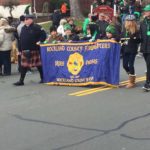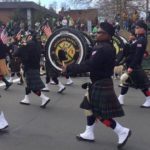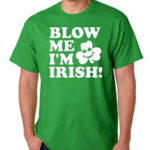Although many towns across America will celebrate St. Patrick’s Day with parades or other such celebrations, Pearl River in New York is one of the few to have the recognition of hosting one of the largest parades outside of New York City. Every year around March 17th, a parade runs through the town following a shamrock painted path. The parade began in the 1950’s due to the influx of Irish immigrants moving from the city to suburbia. The Irish people had come a long way from their urban slum roots, their places being taken by the large influx of immigrants after World War II. The parade has been growing steadily through the years, drawing in crowds from all over. As many as 50,000 spectators come each year to watch, a huge number considering the town’s population resting at a mere 16,000.
The draw to this parade comes from in a large part from the high percentage of Irish families who live in the area. Of the 16,000 that live in Pearl River, 43.4% claim Irish ancestry (one of the highest proportions of Irish Americans in the United States). The parade is deeply rooted in Irish heritage, which is seen through the many organizations led by Irish immigrants.
At each march, young step dancers perform a routine, Gaelic football players show off their skills, and bagpipes can always be heard blasting away. Perhaps even more interesting is that the banners of early Irish rebels like Padraig Pearse and hunger strikers like Bobby Sands are proudly carried in memoriam. This is a reflection of the positive views that the demonstrators carry towards these figures, who were so controversial in the previous century. By literally parading their portraits down a street in front of thousands, it shows that they not only stand in support of them, but that they idolize them as martyrs and heroes. While many of these marchers were born even after the hunger strikes in the 1980s, this goes to show that not only is this sentiment of honoring the Irish rebels held by those who witnessed it; it is also being taught to younger generations. Forgetting the hunger strikers and the 1916 fighters is not something that will happen soon in these Irish communities.
Another one of the many reasons that this parade is so successful each year is that it is backed by many Irish organizations. These include Ancient Order of Hibernians, Irish Northern Aid, Gaelic Athletic Association and numerous pipe bands; clearly the Irish heritage is strong here. This town takes their Irish celebrations very seriously and for that they also are willing to fiercly protect it.
Recently, members of the Irish community joined forces with State Senator David Carlucci to protest shops in Palisades mall. These shops were selling items of clothing that were printed with words that many found offensive. While many protestors had a fair reason to feel insulted, some of the comments they made show a clear definition of those they feel have a true right to celebrate St. Patrick’s day. Neil Cosgrove, the national-defamation chair for Ancient Order of Hibernians, was quoted as saying “For me personally, being Irish isn’t a one day out of 365 thing…” when asked about the annual parade. This sets a tone that says St. Patrick’s day should be celebrated by the “real” Irish. The “real” Irish are people who can set claim to being Irish everyday, not just on the day they can wear their “Irish for the day” shirts. Another protestor used her Catholic and Irish American background to justify her reasons for being allowed to speak out about these kinds of shirts and why they should not be allowed to be worn especially on St. Patrick’s day. This pulls the definition of the “real” Irish even tighter, excluding it purely to Irish Catholics.
While it’s true that St. Patrick’s Day is a Catholic holiday celebrating a catholic saint, it cannot be denied that over the years it’s really transformed into a celebration for all people of Irish descent, and even some who have absolutely no ancestry in Ireland wish to join in on the fun. Limiting who is allowed to celebrate it takes away some of the joy and connections that it gives so many people. There are many Irish immigrants who can be defined as “real” Irish, but there are also many Irish immigrants who are not Catholic or do not identify predominantly as Irish. Then again, many feel as though those who are not Irish taking part in it are simply making fun of their heritage and lessening the meaning. Their wish to restrict it to just Irish Americans may be seen as selfish, but they worry that their traditions are being assailed by other people who just do not understand them. There is no truly correct point of view in this muddled situation.
With all of that being said, St. Patrick’s will continue to be celebrated by Irish and non-Irish Americans alike. Perhaps one of the greatest aspects about St. Patrick’s Day in America is that it connects people of all backgrounds who come together to celebrate Ireland and Irish achievement.
This song truly embodies the sentiment that St. Patrick’s day can be celebrated by everyone, even if they only seem a wee bit Irish.






